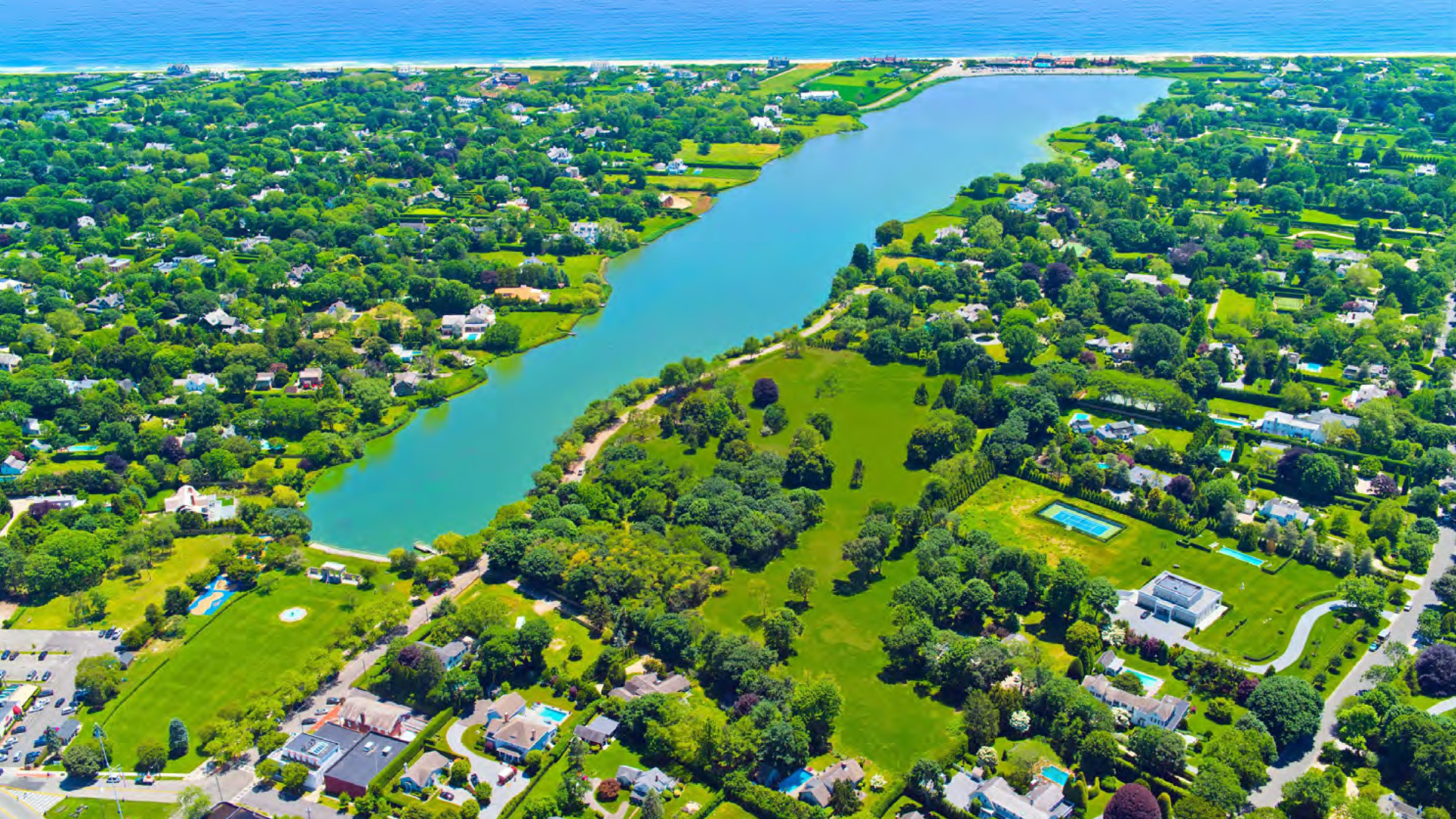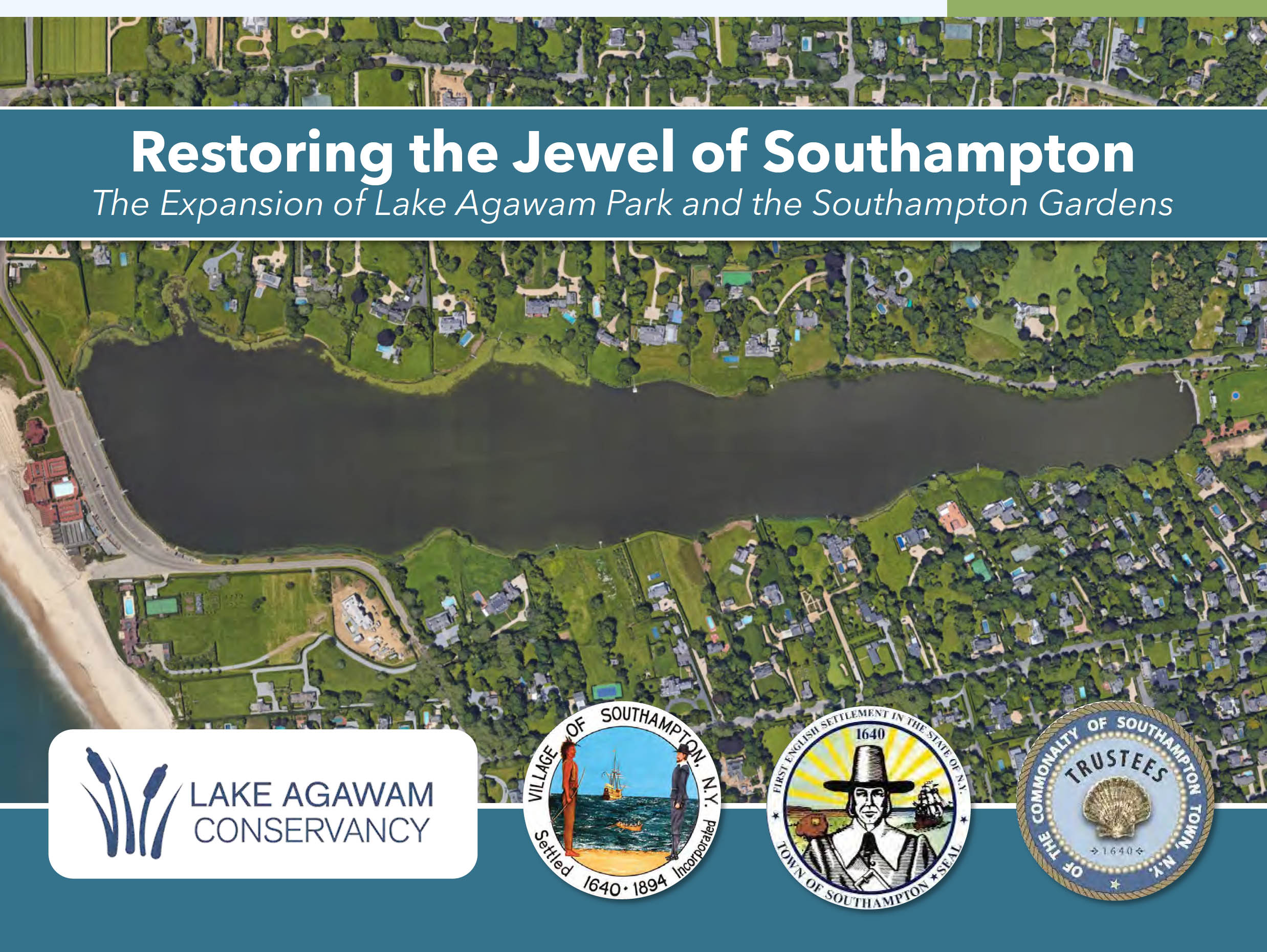
On Tuesday, August 22, Lake Agawam Conservancy presented preliminary plans to the Southampton Village Trustees to preserve more than 11 acres along Lake Agawam for the public, and to create beautiful gardens designed by Southampton resident and world-renowned architect Peter Marino. These plans were developed with the participation—and support—of Southampton Village and Town officials. Thank you to everyone who attended the work session.
This is a once-in-a-lifetime opportunity for the Village of Southampton to preserve 8.4 acres of open space right in the Village’s center, next to 2.9 unused acres already owned by Southampton Town’s Community Preservation Fund (CPF), for a total of more than 11 acres. The preliminary plans, and supporting materials, are now available at southamptonvillage.org.
Lake Agawam Park and the creation of Southampton Gardens will be a multi-step process, with the Town’s CPF’s purchase of 137 Pond Lane as the first step. The Village Trustees will hold a public meeting on this proposal on Thursday, September 14th, at 6 p.m. at the Southampton Cultural Center, 25 Pond Lane. We urge all Village residents to participate in this process. The plans are preliminary and we want your input. If you have any thoughts about the plans, please contact us here.
Following the Central Park Conservancy’s public-private partnership model, the Lake Agawam Conservancy would privately raise funds to install and manage Southampton Gardens. We would also seek additional Town CPF funding for the installation of a buffer of beautiful native vegetation to protect the Lake from stormwater and other toxic runoff.
The planned expansion of Lake Agawam Park and creation of Southampton Gardens would be made possible by the Town CPF’s purchase a building lot at 137 Pond Lane (4.8 acres) and the donation of a building lot at 153 Pond Lane (3.6 acres) by the Paulson Family Foundation. Before the Paulson Family Foundation acquired the lots, developers were circling to acquire them to construct large homes. If that had happened, the opportunity to preserve this land as open space would have been lost forever.
The creation of a beautiful waterfront park and gardens directly along one-quarter mile of Lake Agawam would require the closing of a portion of Pond Lane to motor vehicles. Pond Lane would remain open to pedestrians and bicyclists 24/7. It would not be safe for visitors to have a road in front of the new Southampton Gardens. It would not be safe for pedestrians, bicyclists, sailors and swimmers to compete with cars as they take advantage of what we hope will be a clean Lake Agawam.
The Village’s Master Plan, unanimously supported by the Trustees, cites the two Pond Lane parcels as among the most important CPF priorities in the Village. The Plan recommends increasing the number of bike and pedestrian paths in the Village and the specifically references the closing of Pond Lane to motor vehicles to create more direct public access to Lake Agawam.
The Conservancy’s ultimate goal is a clean Lake Agawam for the benefit of every Village resident. Closing a portion of Pond Lane to motor vehicles would allow for public recreation on a clean Lake Agawam, including for sailing and swimming.
This portion of road along Lake Agawam also needs to be closed to motor vehicles to allow for the creation of an environmental buffer and stormwater drainage along one-quarter mile of the Lake. The runoff from Pond Lane now adversely impacts Lake Agawam, our beaches and our health. There is not sufficient room next to the existing roadway to build an environmental buffer and bicycle and pedestrian path.
The closure of part of Pond Lane to motor vehicles would increase pedestrian and bicycle traffic on Pond Lane and reduce motor vehicle traffic in the Village. Nelson & Pope has conducted traffic studies showing that the closure would not adversely impact Village traffic. There are multiple other ways to drive to the business district from the estate section other than Pond Lane, including Hill Street, Culver Street and Gin Lane.
In the 19th century, Pond Lane was originally built, close to the Lake, for horses and buggies and walking, not construction trucks. There was no need for an environmental buffer. The 90 degree curve on Pond Lane is dangerous. There is no other road in the Village with a similar 90 degree curve. Pond Lane is also unsafe because of the geese that cross the road and disrupt traffic. There has been at least one fatality on Pond Lane.
For generations, Lake Agawam was the “Jewel of Southampton,” the center of Village life. Sadly, by 2018, the Lake became one of the most toxic in New York State. Since the summer of 2019, in coordination with the Village, Town and New York State, the Conservancy has worked to restore the Lake to health. We have installed technology to monitor the real-time health of the Lake, planted bioswales and native gardens, removed invasive water lilies, added 42 aeration bubblers to oxygenate the Lake, and educated the public about chemical-free landscaping.
Next year, Southampton Village will install a permeable reactive barrier underground at Lake Agawam park to block the flow of polluted groundwater. With the Conservancy’s support, the Village has secured $10 million to install an algae harvester, which will treat up to 3 million gallons of Lake Agawam water every day. The placement of this algae harvester in Doscher Park requires that the parkland be acquired at 137 Pond Lane.
The Conservancy’s goal is to restore Lake Agawam’s health to the point that the Lake is safe for swimming, boating and other recreation. The summer colony was founded around Lake Agawam starting at the end of the Nineteenth Century. The proposed expansion of Lake Agawam Park and the creation of Southampton Gardens will once again put the Lake at the center of Village life for every resident.


